

The right kitchen is essential for a chef — even if you only cook for your friends and family in the home! Unfortunately, many kitchens are poorly designed and can limit your potential to craft delicious dishes that impress. Designing the perfect kitchen can take your chef game to the next level.
While you probably won’t be able to replicate every aspect of a restaurant kitchen in your home, you can take inspiration from professionals in several ways. Whether you’re remodeling an existing kitchen or designing an entirely new kitchen space, here are some factors to consider.
Surfaces are extremely important when it comes to food preparation. Any surface that comes into contact with food must be durable, smooth, and easy to clean and keep clean. For countertops, materials like quartz, granite, marble, and ceramic are popular, and for good reason. Wood is also popular, but wooden countertops must be treated. Untreated wood is vulnerable to water damage and scratches from utensils.
You’ll want to install backsplash tiles too, to prevent food stains from damaging walls near stoves and countertops. Ceramic tiles are a great choice here as they’re durable, heat resistant, easy to clean, and come in a range of colors and patterns that can match almost any style of interior design. It’s also easy to fix ceramic if it becomes damaged. Caulks and sealants can be applied not only to mend broken tiles but also to create a watertight seal.
Selecting the right appliances is paramount, but the best choices will vary based on what you want from your kitchen space. When choosing appliances, consider your cooking habits, kitchen size, and budget. For example, you may want a gas stove or an electric one, and a convection oven or a conventional one.
Think about your energy usage, too. Energy-efficient models may cost more initially but can save you money on your utility bills in time. Many appliances also have different cooking modes, and capacity can also vary.
Inadequate ventilation can lead to cooking odors permeating your entire home, as well as a buildup of grease and moisture in the kitchen. As well as making the cooking space less pleasant to be in, moisture can also pose hygiene and safety risks — dampness can lead to mold or even structural damage to your home. Luckily, there are plenty of ventilation options, such as range hoods and exhaust fans. There’s also the tried-and-tested method of opening windows during the warmer months!
Workspace design is an important reason why restaurant kitchens are typically so much more efficient than domestic kitchens. To achieve similar, designate specific zones for meal preparation, cooking, and cleanup to “streamline” your workflow. Place appliances and items according to “point of use” — as much as possible, things should be located where you are when you need to use them.
Keep commonly used ingredients, utensils, and small appliances within easy reach of the cooking area for quick access. Use vertical storage solutions like shelves and racks to maximize space, while drawer dividers can keep items organized.
If you’re designing a kitchen from scratch, or carrying out an extensive remodel, you could even optimize the placement of units and countertops. If so, try to plan the layout in a way that minimizes steps between key areas like the stove, refrigerator, and sink. Popular kitchen layouts like the “work triangle” may be worth researching.
Lighting and Flooring

Without effective lighting, it can be difficult or even unsafe to prepare food. White lighting is often the best choice for examining the appearance of food, and it should be bright enough that you can always see exactly what you are doing.
This may include ambient ceiling lighting for the entire room as well as strategically placed lights to illuminate workspaces, such as the lightbulbs that are built into many range hoods. As well as being vital for safety and functionality, lighting can also contribute to the “feel” of a space and make the kitchen somewhere where you enjoy spending time and following your favorite recipes.
When it comes to flooring, hard, durable surfaces are always best for kitchens. Not only would carpet be a haven for germs left by spilled food and drink, but it would also be a significant fire risk. There’s a reason you’re unlikely to see carpet in any kitchen, let alone a professional one!
Restaurant kitchens must meet a rigorous set of health and safety requirements to continue operating. While you’re unlikely to have a health inspector show up at your home to audit your kitchen, safety is still a vital consideration!
Always remember to keep sharp objects and hot surfaces out of the reach of children, and install smoke and carbon monoxide detectors. Safety should also be at the forefront of your mind in the way that you work in the kitchen — keep surfaces and utensils clean to avoid the spread of bacteria, and set timers to avoid food being left cooking for too long and becoming a fire hazard.
While restaurant kitchens can teach you many lessons in designing the optimal cooking space, you should also remember that the space is your own and should reflect your tastes where possible and appropriate. The perfect kitchen space is a marriage of functionality and personal style. Use your own preferred decorative elements, utensils, and appliancQes you enjoy using, and — of course — prepare the meals that you and your family love!